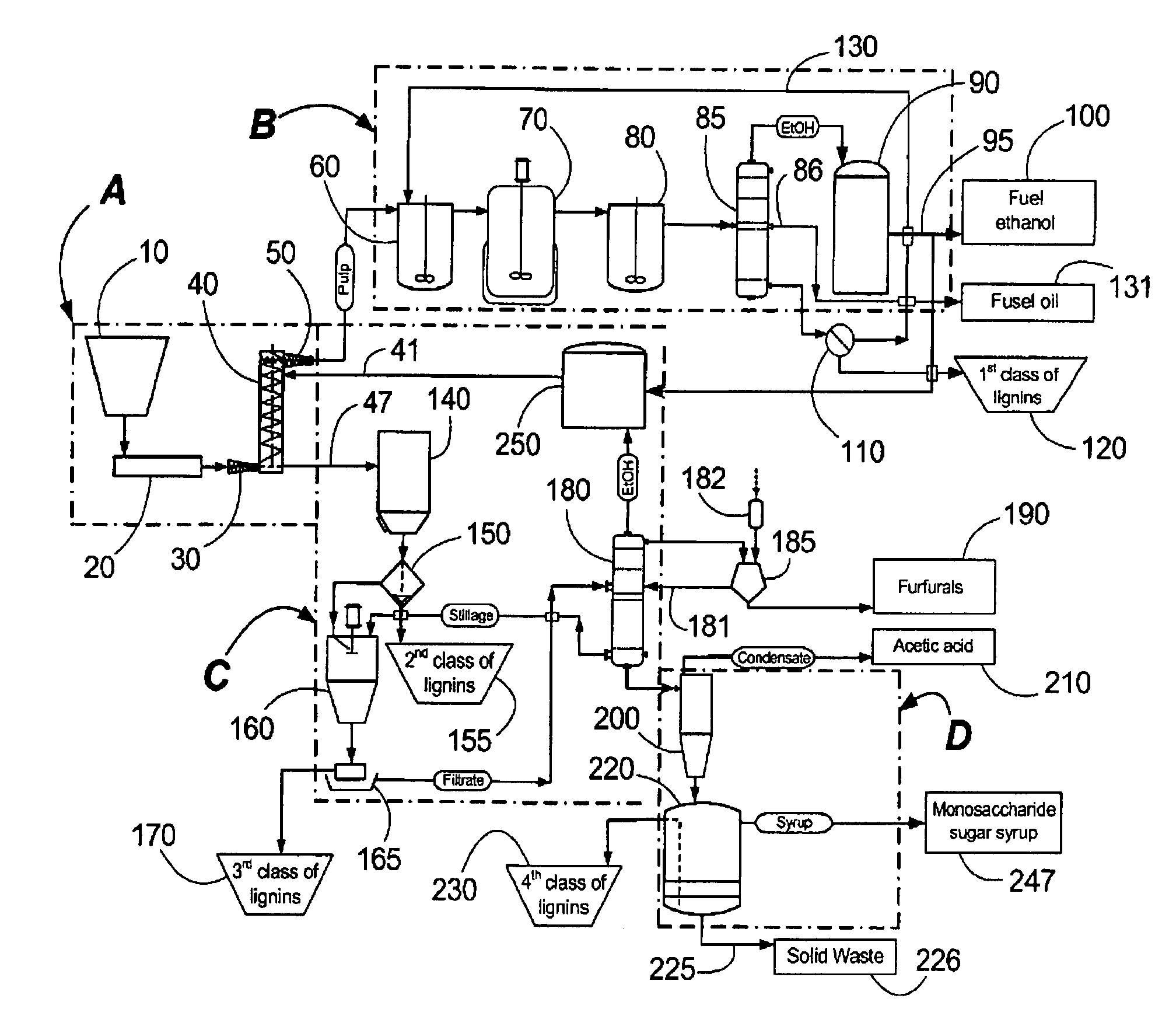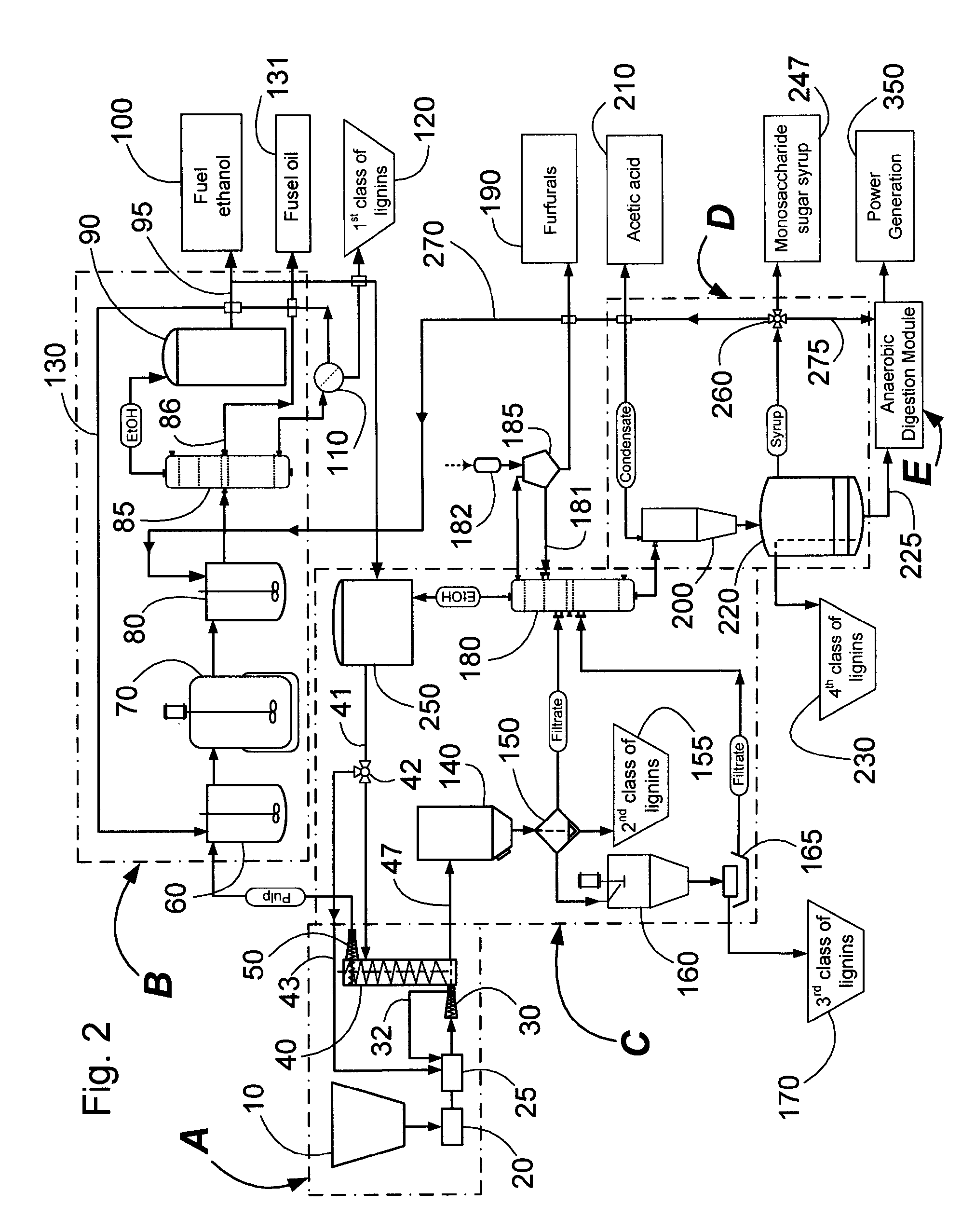Continuous counter-current organosolv processing of lignocellulosic feedstocks
a technology of organosolv and lignocellulosic feedstock, which is applied in the field of lignocellulosic feedstock fractionation, can solve the problems that the current available processes and systems are not yet economically feasible, and achieve the effects of facilitating and enhancing the rates and facilitating and enhancing the rate of concurrent fermentation and/or fermentation efficiencies and/or fermentation yields
- Summary
- Abstract
- Description
- Claims
- Application Information
AI Technical Summary
Benefits of technology
Problems solved by technology
Method used
Image
Examples
example 1
[0060]Representative samples of whole logs of British Columbian aspen (Populus tremuloides) (˜125 years old) were collected. After harvesting, logs were debarked, split, chipped, and milled to a chip size of approximately ≦10 mm×10 mm×3 mm. Chips were stored at room temperature (moisture content at equilibrium was ˜10%). The aspen chips were organosolv-pretreated in aqueous ethanol (50% w / w ethanol) with no addition of exogenous acid or base, in a 2-L PARR® reactor (Parr is a registered trademark of the Parr Instrument Company, Moline, Ill., USA). Duplicate 200 g (ODW) samples of the aspen chips, designated as ASP1, were cooked at 195° C. for 60 min. The liquor:wood ratio was 5:1 weight-based. After cooking, the reactor was cooled to room temperature. Solids and the spent liquor were then separated by filtration. Solids were intensively washed with a hot ethanol solution (70° C.) followed by a tap water wash step. The moisture content of the washed pulp was reduced to about 40% with...
example 2
[0064]Duplicate 200-g samples of the wood chips prepared in Example 1, designated as ASP2, were used for this study. The aspen chips were organosolv-pretreated in aqueous ethanol (50% w / w ethanol) with no addition of exogenous acid or base, in a 2-L PARR® reactor. Duplicate 200 g (ODW) samples of aspen chips were cooked at 195° C. for 90 min. The liquor:wood ratio was 5:1 (w:w). After cooking, the reactor was cooled to room temperature. Solids and liquids were then separated by filtration. Solids were intensively washed with a hot ethanol solution (70° C.) followed by a tap water wash step. The moisture content of the washed pulp was reduced to about 40% with the help of a hydraulic press (alternatively a screw press can be used). The washed pulp was homogenized and stored in a fridge at 4° C. The chemical composition (hexose, pentose, lignin content) of raw chips, washed, and unwashed pulps was determined according to a modified Klason lignin method derived from the Technical Assoc...
example 3
[0068]Duplicate 200-g samples of the wood chips prepared in Example 1, designated as ASP3, were used for this study. The aspen chips were organosolv-pretreated in aqueous ethanol (50% w / w ethanol) with no addition of exogenous acid or base, in a 2-L PARR® reactor. The duplicate samples of aspen chips were cooked in duplicate at 195° C. for 120 min. The liquor:wood ratio was 5:1 (w:w). After cooking, the reactor was cooled to room temperature. Solids and liquids were then separated by filtration. Solids were intensively washed with a hot ethanol solution (70° C.) followed by a tap water wash step. The moisture content of the washed pulp was reduced to about 40% with the help of a hydraulic press (alternatively a screw press can be used). The washed pulp was homogenized and stored in a fridge at 4° C. The chemical composition (hexose, pentose, lignin content) of raw chips, washed, and unwashed pulps was determined according to a modified Klason lignin method derived from the Technical...
PUM
| Property | Measurement | Unit |
|---|---|---|
| temperatures | aaaaa | aaaaa |
| pressures | aaaaa | aaaaa |
| temperatures | aaaaa | aaaaa |
Abstract
Description
Claims
Application Information
 Login to View More
Login to View More - R&D
- Intellectual Property
- Life Sciences
- Materials
- Tech Scout
- Unparalleled Data Quality
- Higher Quality Content
- 60% Fewer Hallucinations
Browse by: Latest US Patents, China's latest patents, Technical Efficacy Thesaurus, Application Domain, Technology Topic, Popular Technical Reports.
© 2025 PatSnap. All rights reserved.Legal|Privacy policy|Modern Slavery Act Transparency Statement|Sitemap|About US| Contact US: help@patsnap.com



